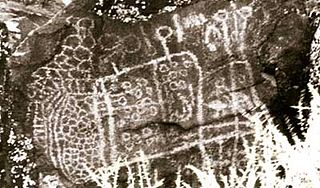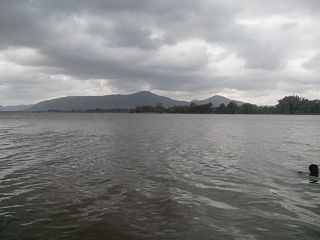
Williamsport is a town in Washington County, Maryland, United States. The population was 1,868 at the 2000 census and 2,137 as of 2010.

The Duwamish River is the name of the lower 12 miles (19 km) of Washington state's Green River. Its industrialized estuary is known as the Duwamish Waterway. Although heavily polluted, it is an important habitat for the wildlife. Important to the Duwamish people, the Duwamish Longhouse and Cultural Center is on the west bank of the river and several parks have indigenous Lushootseed names.

Beacon Hill is a hill and neighborhood in southeastern Seattle, Washington. It is roughly bounded on the west by Interstate 5, on the north by Interstate 90, on the east by Rainier Avenue South, Cheasty Boulevard South, and Martin Luther King Junior Way South, and on the south by the Seattle city boundary. It is part of Seattle's South End.
The direct historical approach to archaeology was a methodology developed in the United States of America during the 1920s-1930s by William Duncan Strong and others, which argued that knowledge relating to historical periods is extended back into earlier times. This methodology involves taking an archaeological site that has historical accounts relating to recent periods of occupation and then excavating it to establish continuity back into prehistoric times. The historical data then becomes the basis of analogy and homology for the study of the prehistoric communities at both the particular site and other sites in the region. The main issue with the approach is that in many parts of the world there is no direct continuity between historically documented communities and the prehistoric occupants of the region.

The city of Seattle, Washington, is located on a narrow isthmus between Puget Sound on the west and Lake Washington on the east; water comprises approximately 41% of the total area of the city. It was founded on the harbor of Elliott Bay, home to the Port of Seattle—in 2002, the 9th busiest port in the United States by TEUs of container traffic and the 46th busiest in the world.

Butchers Hill is a neighborhood in Southeast Baltimore, Maryland, United States. It is north of Fells Point, east of Washington Hill, and northwest of Patterson Park. It is south of Fayette Street, west of Patterson Park Avenue, north of Pratt Street, and east of Washington Street. It is in the 21231 zip code.
The Pierce Site is a Pre-Columbian archaeological site in Apalachicola, Florida. It is located approximately 1 mile northwest of Apalachicola on 12th Street. On January 11, 1974, it was added to the U.S. National Register of Historic Places. It was occupied during the Middle Woodland Period, which includes ceramics of early Weeden Island and Swift Creek types. It also was occupied during the late prehistoric Fort Walton Period.

List of the National Register of Historic Places listings in Bergen County, New Jersey

Lockheed Shipbuilding and Construction Company, was a shipyard in Seattle, Washington with Yard 1 on Harbor Island and Yard 2 at what is now Jack Block Park at Seattle Terminal 5, both at the mouth of the West Waterway of Duwamish River. Yard 1 was founded in 1898 as the Puget Sound Bridge and Dredging Company, the company that built Harbor Island, and it was purchased by Lockheed in 1959. Yard 2 began operation in 1943 to build ships for the US Navy. The shipyard was permanently closed in 1988; Yard 2 was sold in 1989, and Yard 1 was sold in 1997, both to Port of Seattle.

Big and Little Petroglyph Canyons are two principal landforms within which are found major accumulations of Paleo-Indian and/or Native American Petroglyphs, or rock art, by the Coso People located in the Coso Range Mountains of the northern Mojave Desert, and now within the Naval Air Weapons Station China Lake, near the towns of China Lake and Ridgecrest, California. Little Petroglyph Canyon contains 20,000 documented images, which surpasses in number for most other collections. Additionally, the archeological resources are remarkably undisturbed.

Salona, in McLean, Virginia, is a former plantation house on the National Register of Historic Places surrounded by land protected by two conservation easements. The Salona homestead and grounds comprise 7.8 acres (3.2 ha) within the 52.4-acre (21.2 ha) site, and are protected by a 1971 easement held by the Fairfax Board of Supervisors. A much newer conservation easement held by the Northern Virginia Conservation Trust added an additional 41 acres (17 ha), of which 10 acres (4.0 ha) will be placed in active recreational use, and the rest used for passive recreation, such as trails.

List of the National Register of Historic Places listings in Passaic County, New Jersey

The Cimarron Historic District is a historic district on the south side of Cimarron, New Mexico, United States. The district is located south of US Route 64 on the east and west sides of New Mexico Highway 21. In 1973, the district was added to the U.S. National Register of Historic Places. According to the National Register, the district contains 1,940 acres and contains 6 significant buildings.

Camp Muir, named for the naturalist John Muir, is a high-altitude refuge for climbers in Mount Rainier National Park in Washington, accessed through the Paradise Entrance. The shelters comprising the camp are situated at a 10,188 ft (3,105 m) elevation between the Muir Snowfield and the Cowlitz Glacier on Mount Rainier. Camp Muir is the most-used high camp for those attempting to climb to the mountain's summit. Camp Muir is between the Nisqually and Paradise Glaciers.

This is a list of properties on the National Register of Historic Places in Vermilion County, Illinois.

This list includes properties and districts listed on the National Register of Historic Places in Buncombe County, North Carolina. Click the "Map of all coordinates" link to the right to view an online map of all properties and districts with latitude and longitude coordinates in the table below.

Belakavadi or Belakawadi is a village in the southern state of Karnataka, India. It is located in the Malavalli taluk of Mandya district in Karnataka. As per the records of Hoysala rulers, Belakavadi was one of the central places of administrative divisions. Its temples include Shanbhulingeshwara Temple, Kashi Vishwanatheshwara Temple and maramma temple, Mayamma temple, Mandalakamma temple etc.

The Herndon Depot Museum, also known as the Herndon Historical Society Museum, is located in the town of Herndon in Fairfax County, Virginia. Built in 1857 for the Alexandria, Loudoun & Hampshire Railroad, the depot later served the Richmond and Danville Railroad, the Southern Railway and the Washington and Old Dominion Railroad. In 1875, the original shed was replaced with the current depot.
The Evelyn Site, also referred to as Illinois Archaeological Survey No. Ke-52, is a 12-acre (4.9 ha) archaeological site near Newark in Big Grove Township, Kendall County, Illinois, United States.















